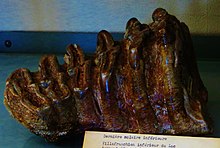Mammuthus africanavus
| Mammuthus africanavus Temporal range:
| |
|---|---|

| |
| Molar found in Tunisia | |
| Scientific classification | |
| Domain: | Eukaryota |
| Kingdom: | Animalia |
| Phylum: | Chordata |
| Class: | Mammalia |
| Order: | Proboscidea |
| Family: | Elephantidae |
| Genus: | †Mammuthus |
| Species: | †M. africanavus
|
| Binomial name | |
| †Mammuthus africanavus (Arambourg, 1952)
| |
| Synonyms | |
|
Elephas africanavus Arambourg, 1952 | |
Mammuthus africanavus (literally, "African ancestor mammoth") is a species of mammoth known from remains spanning the Late Pliocene-Early Pleistocene found in Central and North Africa in the countries of Chad, Morocco, Tunisia and Algeria. It was originally described by Camille Arambourg in 1952 based on remains found around Lake Ichkeul in north Tunisia as a species of Elephas (which contains the living Asian elephant).[1] Some specimens from this sample may genuinely represent Elephas rather than Mammuthus, though the holotype has been argued to likely represent a true mammoth.[2] Some authors have argued that the species should be placed in Loxodonta (which contains living African elephants), reflecting the difficulty in distinguishing the teeth of early elephantids.[1] It is distinguished from the earlier Mammuthus subplanifrons by having a higher number of ridges/lamellae on the teeth (around 9-10 on the third molars), which display a greater parallelity, the molars being more hypsodont (high crowned),[1] with the molars having a greater amount of cementum and thinner enamel, and the molar plates exhibit closer spacing.[3]
The species is primarily known from dental remains. The skull and lower jaws of an old adult male mammoth, now apparently lost, referred to M. africanavus, has been reported from Garet et Tir, Algeria, dating to the Late Pliocene. The specimen, though somewhat damaged and distorted when described unambiguously represents a mammoth, with a tall skull over 1.45 metres (4.8 ft) in height with an especially short basicranium, and narrow palate. The specimen had twisted tusks at least 2.3 metres (7.5 ft) long, which were narrowly separated from each other in their elongate tusk sheaths/sockets/alveoli, but sharply diverged from each other following their emergence from the skull. The skull was described by Maglio (1973) as similar to that of the primitive Eurasian mammoth species Mammuthus meridionalis.[1]
Specimens intermediate between M. subplanifrons and M. africanavus have been reported from the Late Pliocene Hadar Formation, Ethiopia, dating to around 3.5 million years ago.[3] The oldest specimens of M. africanavus date to around 3.5-3 million years ago, while the youngest specimen dates to around 2.32-2 million years ago.[1]
At Aïn Boucherit in Algeria during the Early Pleistocene, the species lived alongside members of the genus Hippopotamus, rhinoceroses belonging to the genus Ceratotherium (which contains the living white rhinoceros), the suid (pig) Kolpochoerus, equines belonging to the genus Equus and Hipparion, the giant giraffid Sivatherium, the gomphothere Anancus, bovines, antelopes (Gazella, Kobus, Damaliscus, Megalotragus, Parmularius, Oreonagor and Parantidorcas) and canines (Canis, Vulpes).[4]
References
[edit]- ^ a b c d e Sanders, William J. (2023-07-07). Evolution and Fossil Record of African Proboscidea (1 ed.). Boca Raton: CRC Press. pp. 245, 263–266. doi:10.1201/b20016. ISBN 978-1-315-11891-8.
- ^ Markov, Georgi N. (October 2012). "Mammuthus rumanus, early mammoths, and migration out of Africa: Some interrelated problems". Quaternary International. 276–277: 23–26. Bibcode:2012QuInt.276...23M. doi:10.1016/j.quaint.2011.05.041.
- ^ a b Sanders, William J.; Haile-Selassie, Yohannes (June 2012). "A New Assemblage of Mid-Pliocene Proboscideans from the Woranso-Mille Area, Afar Region, Ethiopia: Taxonomic, Evolutionary, and Paleoecological Considerations". Journal of Mammalian Evolution. 19 (2): 105–128. doi:10.1007/s10914-011-9181-y. ISSN 1064-7554.
- ^ Sahnouni, Mohamed; Van der Made, Jan; Everett, Melanie (June 2011). "Ecological background to Plio-Pleistocene hominin occupation in North Africa: the vertebrate faunas from Ain Boucherit, Ain Hanech and El-Kherba, and paleosol stable-carbon-isotope studies from El-Kherba, Algeria". Quaternary Science Reviews. 30 (11–12): 1303–1317. Bibcode:2011QSRv...30.1303S. doi:10.1016/j.quascirev.2010.01.002.
